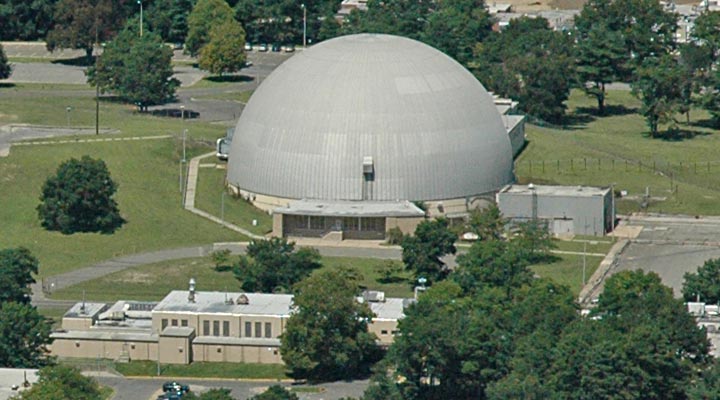Why is the High Flux Beam Reactor Being Decommissioned?
 The
High Flux Beam Reactor (HFBR) at Brookhaven National Laboratory (BNL)
is being decommissioned because the Department of Energy (DOE) decided in 1999
that it would be permanently closed. The reactor was shut down in 1997 after
tritium from a leak in the spent-fuel pool was found in the groundwater.
The
High Flux Beam Reactor (HFBR) at Brookhaven National Laboratory (BNL)
is being decommissioned because the Department of Energy (DOE) decided in 1999
that it would be permanently closed. The reactor was shut down in 1997 after
tritium from a leak in the spent-fuel pool was found in the groundwater.
The HFBR, which had operated from 1965 to 1996, was used solely for scientific research, providing neutrons for materials science, chemistry, biology, and physics experiments. The reactor was shut down for routine maintenance in November of 1996. In January 1997, tritium, a radioactive form of hydrogen and a by-product of reactor operations, was found in groundwater monitoring wells immediately south of the HFBR. The tritium concentrations were above state and federal drinking water standards. Operations at the HFBR were suspended while the source of the tritium was investigated. The investigation revealed a small leak in the pool where spent reactor fuel was stored. BNL subsequently determined that tritiated water had been leaking from the spent-fuel pool located in the basement of the HFBR building for more than a decade.
Response to the leak was swift. In cooperation with the U.S. Environmental Protection Agency (EPA) and the Suffolk County Department of Health Services, BNL installed 140 groundwater monitoring wells and analyzed over 1,000 samples. The extent of the tritium contamination was defined and groundwater containing tritium at levels above the drinking water standard was found to extend approximately 2,200 feet south of the reactor; well within the BNL site. In May 1997, a pump-and-recharge system was installed at the southern edge of the contamination to prevent it from spreading further and confine it to Laboratory property.
While BNL addressed tritium contamination and groundwater issues, the Department of Energy grappled with the decision of what to do with the reactor, which had been placed in stand-by mode. In 1998, Congress directed DOE to prepare an Environmental Impact Statement (EIS), under the National Environmental Policy Act (NEPA) to evaluate the effect that the HFBR had on the environment. BNL began the EIS process, but in November of 1999, before the document was completed, DOE decided to permanently close the HFBR. Then Secretary of Energy Bill Richardson cited the following reasons for the decision to close the reactor: the length of time it would take to complete the EIS, a limited budget, and the availability of other neutron research facilities.
Safe, Secure Shutdown
Many planning studies, including a preliminary assessment, a site investigation, facility characterization, a metallurgical analysis, and risk assessments were conducted upon shutdown of the reactor. In 2000, the HFBR was transferred to the BNL Environmental Restoration Projects for surveillance and maintenance and eventual decommissioning. DOE and BNL worked with local, state, and federal regulatory agencies to develop the decommissioning plan. A Feasibility Study (PDF) and Proposed Remedial Action Plan (PDF) that outline final decontamination and decommissioning steps for the HFBR were prepared, and a HFBR_Final_ROD.pdf (PDF) was approved in February, 2009 that selected the final remedy.
From 1999 through 2011 many decommissioning and preparation for safe storage actions were taken throughout the 13-acre HFBR complex including, removal and disposal of HFBR fuel and primary coolant; shipment of equipment for reuse at other facilities; cleanup and transfer of the Cold Neutron Facility for reuse; dismantling of many ancillary buildings in the HFBR complex; removal of contaminated underground utilities and piping; removal and disposal of the reactor control rod blades and beam plugs; and preparation of the confinement building for safe storage. Most of the experimental research equipment is being reused by other BNL facilities, by other U.S. government or university laboratories, or by researchers in South Korea, England, and Australia. Learn more about the clean-up actions.
The HFBR complex has been placed, and is currently being maintained, in a safe and stable condition. Final decommissioning of the HFBR confinement building will be performed at the completion of the decay period (not to exceed 65 years). The HFBR complex was transferred to the Environmental Protection Division in 2012 for long-term surveillance and maintenance of the complex and for demolition of the HFBR Stack by fiscal year 2020. Learn more about the surveillance and maintenance activities.


